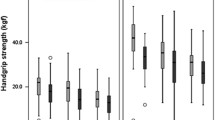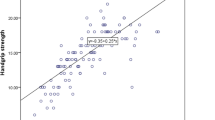Abstract
Introduction
In Mini-Nutritional Assessment-Short Form (MNA-SF) test, a practical and reliable alternative parameter is still necessary for patients with difficult body mass index evaluation. We aimed to show whether or not handgrip strength may be used instead of body mass index (BMI) in MNA-SF test.
Materials and Methods
MNA-SF test scores, calf circumferences (CC), handgrip strength (HGS), and BMI of 191 patients were evaluated. The first one of calculated MNA-SF tests was with BMI, the second one with CC, and the last one with HGS. Zero point was given if CC was <31 cm and 3 points were given if CC was ≥31 cm. Zero, 1, 2, and 3 points were given if the loss of HGS when compared to expected HGS were ≥%60, from ≥%30 to <%60, from ≥%10 to <%30, and <%10 or greater than expected HGS, respectively. MNA-SF scores and nutritional status according to these three measures were compared.
Results
Mean age and median MNA-SF scores of the patients were 75±7.6 years and 12 points (min-max: 0-14) respectively. There were strongly positive correlations between MNA-SF scores with BMI and CC, with BMI and HGS, and with CC and HGS (r=0.938 p<0.001, r=0.938 p<0.001, r=0.914 p<0.001, respectively). Substantial agreement in nutritional status of the patients were seen between MNA-SF groups with BMI and CC, with CC and HGS, and with BMI and HGS (kappa: 0.795 p<0.001, kappa: 0.709 p<0.001, and kappa: 0.760 p<0.001, respectively).
Conclusions
HGS might be considered instead of BMI in MNA-SF test to assess nutritional status of geriatric patients.




Similar content being viewed by others
References
Barker LA, Gout BS, Crowe TC. Hospital malnutrition: prevalence, identification and impact on patients and the healthcare system. Int J Environ Res Public Health 2011;8(2):514–27
Sarikaya D, Halil M, Kuyumcu ME, Kilic MK, Yesil Y, Kara O, Ozturk S, Gungor E, Karabulut E, Balam Yavuz B, et al. Mini nutritional assessment test long and short form are valid screening tools in Turkish older adults. Archives of gerontology and geriatrics 2015;61(1):56–60
Kondrup J, Rasmussen HH, Hamberg O, Stanga Z, Ad Hoc EWG. Nutritional risk screening (NRS 2002): a new method based on an analysis of controlled clinical trials. Clinical nutrition 2003;22(3):321–36
Stratton RJ, Hackston A, Longmore D, Dixon R, Price S, Stroud M, King C, Elia M. Malnutrition in hospital outpatients and inpatients: prevalence, concurrent validity and ease of use of the ‘malnutrition universal screening tool’ (‘MUST’) for adults. The British journal of nutrition 2004;92(5):799–808
Kaiser MJ, Bauer JM, Ramsch C, Uter W, Guigoz Y, Cederholm T, Thomas DR, Anthony P, Charlton KE, Maggio M, et al. Validation of the Mini Nutritional Assessment short-form (MNA-SF): a practical tool for identification of nutritional status. The journal of nutrition, health & aging 2009;13(9):782–8
Kuyumcu ME, Yesil Y, Ozturk ZA, Halil M, Ulger Z, Yavuz BB, Cankurtaran M, Gungor E, Erdogan G, Besler T, et al. Challenges in nutritional evaluation of hospitalized elderly; always with mini-nutritional assessment? European geriatric medicine 2013;4:231–6
Martin A, Ruiz E, Sanz A, Garcia JM, Gomez-Candela C, Burgos R, Matia P, Ramalle-Gomera E. Accuracy of Different Mini Nutritional Assessment Reduced Forms to Evaluate the Nutritional Status of Elderly Hospitalised Diabetic Patients. The journal of nutrition, health & aging 2016;20(4):370–5
Halil M, Ulger Z, Varli M, Doventas A, Ozturk GB, Kuyumcu ME, Yavuz BB, Yesil Y, Tufan F, Cankurtaran M, et al. Sarcopenia assessment project in the nursing homes in Turkey. European journal of clinical nutrition 2014;68(6):690–4
Ozkayar N, Altun B, Halil M, Kuyumcu ME, Arik G, Yesil Y, Yildirim T, Yilmaz R, Ariogul S, Turgan C. Evaluation of sarcopenia in renal transplant recipients. Nephrourology monthly 2014;6(4):e20055
Patel HP, Syddall HE, Jameson K, Robinson S, Denison H, Roberts HC, Edwards M, Dennison E, Cooper C, Aihie Sayer A. Prevalence of sarcopenia in communitydwelling older people in the UK using the European Working Group on Sarcopenia in Older People (EWGSOP) definition: findings from the Hertfordshire Cohort Study (HCS). Age and ageing 2013;42(3):378–84
de Souza Vasconcelos KS, Domingues Dias JM, de Carvalho Bastone A, Alvarenga Vieira R, de Souza Andrade AC, Rodrigues Perracini M, Oliveira Guerra R, Correa Dias R. Handgrip Strength Cutoff Points to Identify Mobility Limitation in Community-dwelling Older People and Associated Factors. The journal of nutrition, health & aging 2016;20(3):306–15
Stone SP, Ali B, Auberleek I, Thompsell A, Young A. The Barthel index in clinical practice: use on a rehabilitation ward for elderly people. J R Coll Physicians Lond 1994;28(5):419–23
Lawton MP, Brody EM. Assessment of older people: self-maintaining and instrumental activities of daily living. The Gerontologist 1969;9(3):179–86
Shua-Haim J, Koppuzha G, Gross J. A simple scoring system for clock drawing in patients with Alzheimer’s disease. Journal of the American Geriatrics Society 1996;44(3):335
Folstein MF, Folstein SE, McHugh PR. «Mini-mental state». A practical method for grading the cognitive state of patients for the clinician. Journal of psychiatric research 1975;12(3):189–98
Yesavage JA, Brink TL, Rose TL, Lum O, Huang V, Adey M, Leirer VO. Development and validation of a geriatric depression screening scale: a preliminary report. Journal of psychiatric research 1982;17(1):37–49
Cruz-Jentoft AJ, Baeyens JP, Bauer JM, Boirie Y, Cederholm T, Landi F, Martin FC, Michel JP, Rolland Y, Schneider SM, et al. Sarcopenia: European consensus on definition and diagnosis: Report of the European Working Group on Sarcopenia in Older People. Age and ageing 2010;39(4):412–23
Roberts HC, Denison HJ, Martin HJ, Patel HP, Syddall H, Cooper C, Sayer AA. A review of the measurement of grip strength in clinical and epidemiological studies: towards a standardised approach. Age and ageing 2011;40(4):423–9
Norman K, Stobaus N, Gonzalez MC, Schulzke JD, Pirlich M. Hand grip strength: outcome predictor and marker of nutritional status. Clinical nutrition 2011;30(2):135–42
Flood A, Chung A, Parker H, Kearns V, O’Sullivan TA. The use of hand grip strength as a predictor of nutrition status in hospital patients. Clinical nutrition 2014;33(1):106–14
Saletti A, Lindgren EY, Johansson L, Cederholm T. Nutritional status according to mini nutritional assessment in an institutionalized elderly population in Sweden. Gerontology 2000;46(3):139–45
Slee A, Birch D, Stokoe D. A comparison of the malnutrition screening tools, MUST, MNA and bioelectrical impedance assessment in frail older hospital patients. Clinical nutrition 2015;34(2):296–301
Asiimwe SB. Simplifications of the mini nutritional assessment short-form are predictive of mortality among hospitalized young and middle-aged adults. Nutrition 2016;32(1):95–100
Author information
Authors and Affiliations
Corresponding author
Rights and permissions
About this article
Cite this article
Kizilarslanoglu, M.C., Kilic, M.K., Gokce, D. et al. Is it possible using handgrip strength instead of body mass index in MNA-SF test to assess the nutritional status of geriatric patients?. J Nutr Health Aging 21, 579–584 (2017). https://doi.org/10.1007/s12603-016-0744-8
Received:
Accepted:
Published:
Issue Date:
DOI: https://doi.org/10.1007/s12603-016-0744-8




